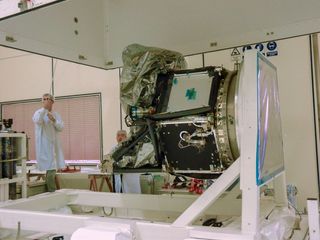
A European exoplanet-studying spacecraft has been cleared for liftoff this fall.
The Characterizing Exoplanet Satellite (CHEOPS) recently passed a crucial review designed to assess the spacecraft's readiness for flight and ability to meet major mission goals, European Space Agency (ESA) officials announced on Monday (March 11).
On Feb 19, "a board of experts met to draw its conclusions and declared, to the satisfaction of the project team, that CHEOPS is indeed ready for flight," ESA officials said in a statement. "All eyes can now turn to launch and in-flight operations."
Related: The Strangest Alien Planets (Gallery)
If all goes according to plan, CHEOPS will soar to Earth orbit this fall from Europe's spaceport in Kourou, French Guiana, atop a Soyuz rocket operated by France-based company Arianespace. The launch window spans Oct. 15 through Nov. 14.
CHEOPS will study stars already known to host planets, especially worlds in the Earth-to-Neptune size range. The spacecraft will monitor these exoplanets' "transits" across their host stars' faces, measuring the resulting brightness dips over an operational life designed to last at least 3.5 years. (NASA's Transiting Exoplanet Survey Satellite hunts for alien worlds using the same strategy, as did the U.S. space agency's prolific Kepler space telescope.)

"The information will enable precise measurements of the sizes of the orbiting planets to be made," ESA officials said in a different statement. "Combined with measurements of the planet masses, this will provide an estimate of their mean density — a first step to characterizing planets outside our solar system."
Get the Space.com Newsletter
Breaking space news, the latest updates on rocket launches, skywatching events and more!
CHEOPS research will be achieved on the cheap; it's a small-class mission, meaning it costs about 50 million euros ($56.5 million at current exchange rates).
ESA has several other exoplanet missions in development. PLATO (Planetary Transits and Oscillations of Stars), scheduled for launch in 2026, will hunt for rocky alien worlds that may be capable of supporting life. And the Atmospheric Remote‐sensing Infrared Exoplanet Large‐survey spacecraft, ARIEL, will lift off in 2028 to search for compositional links between exoplanets and their host stars.
In addition, the Gaia spacecraft, which launched in December 2013 to create an ultraprecise, 3D map of the Milky Way galaxy, will likely end up discovering thousands of exoplanets by the time its work is done, ESA officials have said.
Mike Wall's book about the search for alien life, "Out There" (Grand Central Publishing, 2018; illustrated by Karl Tate), is out now. Follow him on Twitter @michaeldwall. Follow us on Twitter @Spacedotcom or Facebook.
Join our Space Forums to keep talking space on the latest missions, night sky and more! And if you have a news tip, correction or comment, let us know at: community@space.com.

Michael Wall is a Senior Space Writer with Space.com and joined the team in 2010. He primarily covers exoplanets, spaceflight and military space, but has been known to dabble in the space art beat. His book about the search for alien life, "Out There," was published on Nov. 13, 2018. Before becoming a science writer, Michael worked as a herpetologist and wildlife biologist. He has a Ph.D. in evolutionary biology from the University of Sydney, Australia, a bachelor's degree from the University of Arizona, and a graduate certificate in science writing from the University of California, Santa Cruz. To find out what his latest project is, you can follow Michael on Twitter.
